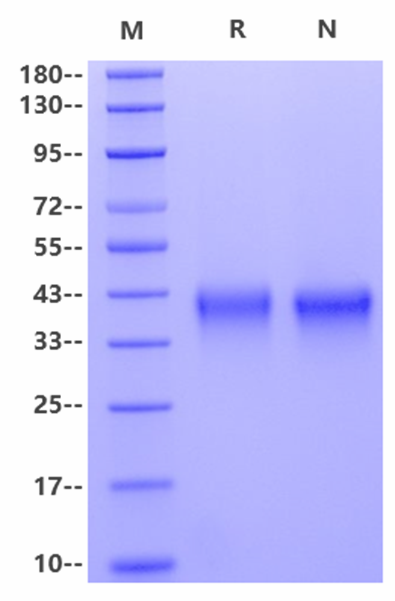Gln23-Ser213, with C-terminal 8*His
QGPGGALGNRHAVYWNSSNQHLRREGYTVQVNVNDYLDIYCPHYNSSGVGPGAGPGPGGGAEQYVLYMVSRNGYRTCNASQGFKRWECNRPHAPHSPIKFSEKFQRYSAFSLGYEFHAGHEYYYISTPTHNLHWKCLRMKVFVCCASTSHSGEKPVPTLPQFTMGPNVKINVLEDFEGENPQVPKLEKSISGGGSHHHHHHHH
>95% by SDS-PAGE
Ephrin‑A3, also known as EHK1‑L, EFL‑2, and LERK‑3, is an approximately 25 kDa member of the Ephrin‑A family of GPI‑anchored ligands that bind and induce the tyrosine autophosphorylation of Eph receptors. Ephrin‑A ligands are structurally related to the extracellular domains of the transmembrane Ephrin‑B ligands. Eph‑Ephrin interactions are widely involved in the regulation of cell migration, tissue morphogenesis, and cancer progression. Ephrin‑A3 preferentially interacts with receptors in the EphA family. Ephrin‑A3 is an unusual Ephrin‑A molecule in its dependence on heparan sulfate binding for full activity. Mature human Ephrin‑A3 shares 92% aa sequence identity with mouse and rat Ephrin‑A3. Its expression is restricted to discreet locations during the early development of multiple tissues. Ephrin‑A3 expression can be up‑ or down‑regulated by hypoxia in the hippocampus or vascular endothelial cells, respectively. Ephrin‑A3 down‑regulation contributes to hypoxia‑induced endothelial cell chemotaxis, proliferation, and tubule formation. Its interaction with EphA receptors induces neurite growth cone collapse and the repulsion of migrating axons. This activity is important for the accurate pathfinding of migrating axons during CNS development. Astrocyte‑expressed Ephrin‑A3 activates EphA4 on hippocampal neurons to regulate dendritic spine morphology and long-term potentiation. The same interaction induces reverse signaling through Ephrin‑A3 to regulate glutamate uptake by the astrocyte and the availability of glutamate in the synapse. Astrocyte‑expressed Ephrin‑A3 also interacts with EphA7 to inhibit the proliferation of neural progenitor cells.
